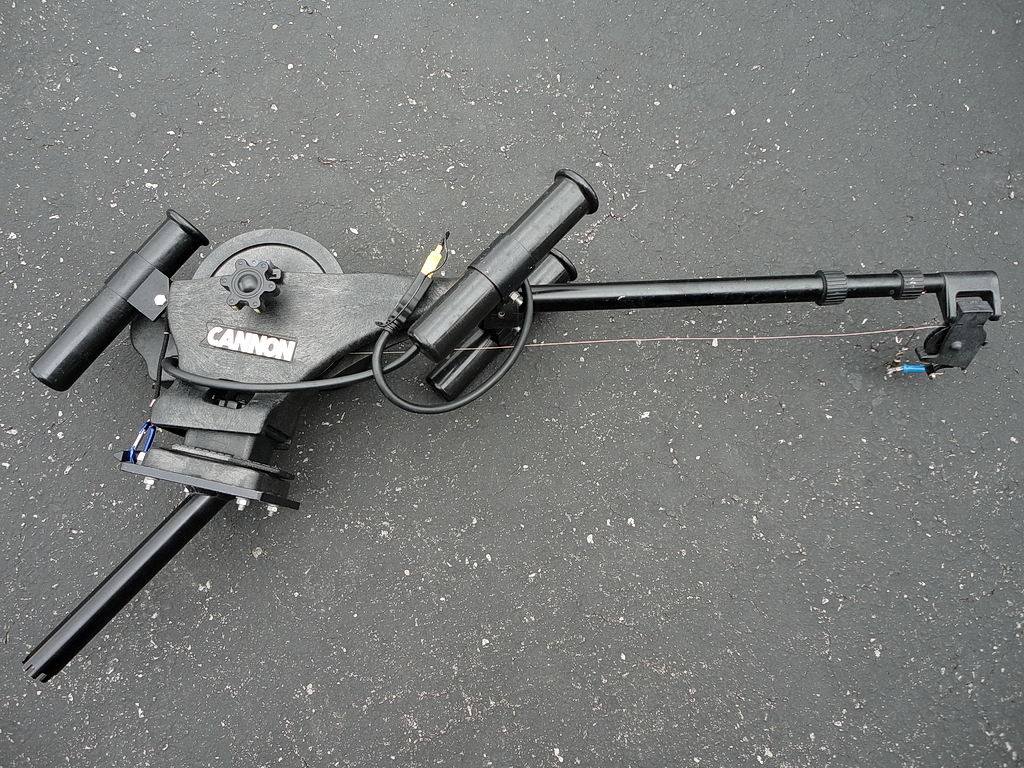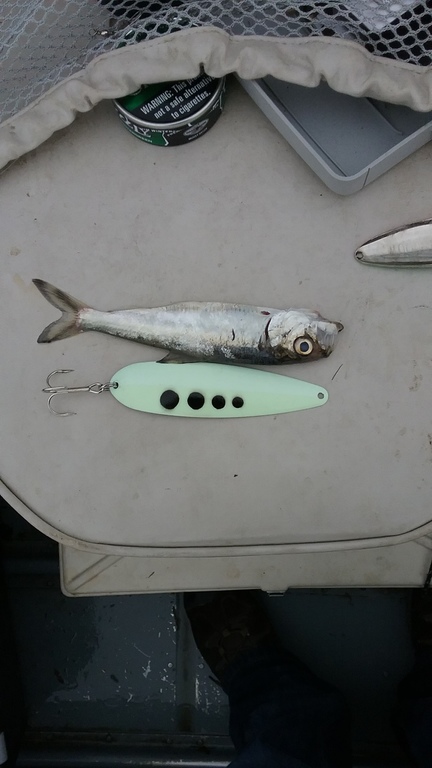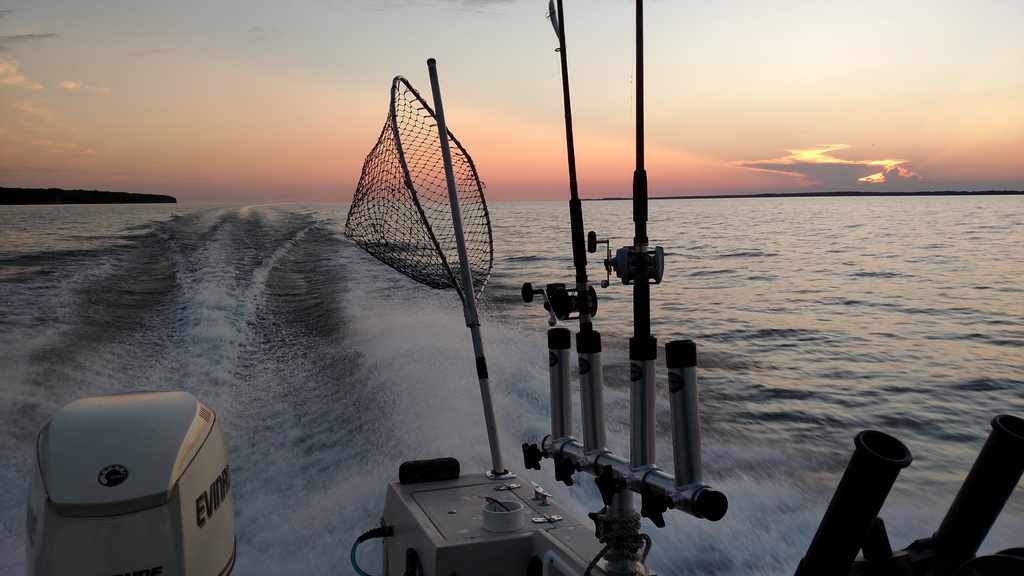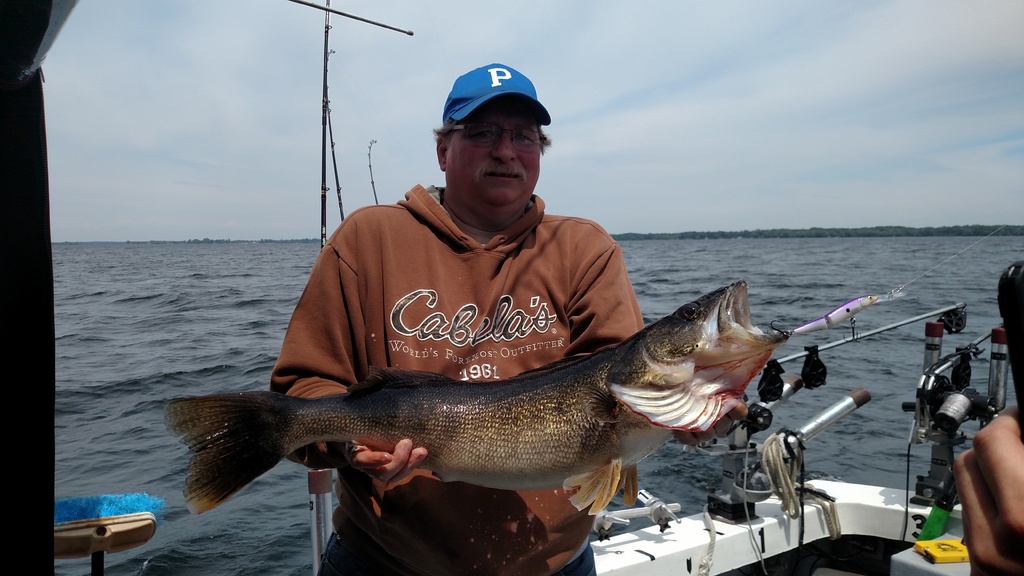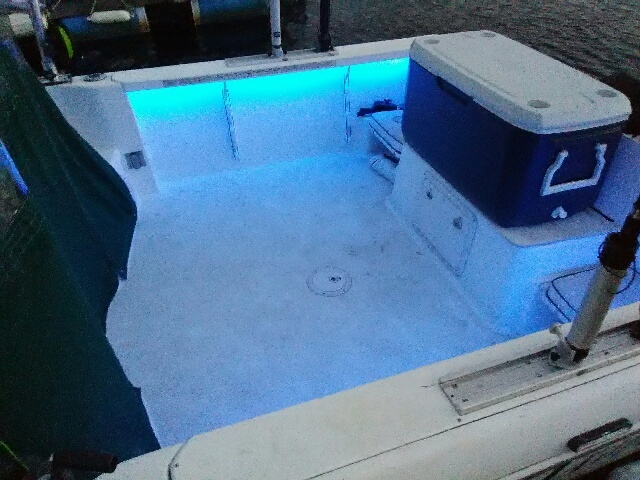-
Posts
13,873 -
Joined
-
Last visited
Everything posted by Sk8man
-
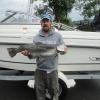
prepare downriggers for lake fishing
Sk8man replied to greenfish's topic in Questions About Trout & Salmon Trolling?
Just a suggestion: Instead of buying NEW look for used ones here on LOU since you are unsure of what you actually want/need. Consider using what you already have for mounts and go wihth the gimbal mounts that fit in the recessed holes you already have. See if any Cannon mag 10's with extendable booms are available. They will be relatively inexpensive but durable although slow to bring up your weights (which I consider an advantage as I rig things while it is coming up). Stick with 10 lb weights on them so the motors aren't stressed as they are the recommended max weight. Get the swivel mounts for them...comes in handy docking etc. If you decide you don't like the electric downriggers you could always deal for some manuals on here with someone moving up to electrics.Here is a pic of my setup that I have used for 15 years without problem (three of them). Pictured is the gimbal, swivel base and downrigger. I have plug ins that any marina should be able to provide you with for the electrical connection. Get 4 of them installed near your recessed holders and then you can switch positions as desired. You can also get another set of gimbals and set up Berts tracks on them and locate rod holders for dipseys etc. on them and likewise can reposition them anywhere in the four holes. -
When I was a kid alewwife die offs were very common and they covered whole beaches at the north end of the lake and smelled like H. It appears to be a natural part of their population cycle. We saw many floating during the derby including some that had been hit with slash marks and none had a red hemorrhage area on them that I believe is characteristic of the disease. The answer to the question about using the dead sawbellies as bait is "yes" but only to be used on the particular lake in which you took it from. They work best when frozen for meat rigs or behind Hemlock spinners or straight gang hooks, or on a jig for jigging (can use either just the head or the tail as well. and scrunched up so they spin if used behind any meat rig. One of the potential problems though is proving the source of the bait if ever questioned by a DEC officer.....kinda tough to prove but on the other hand I have never been asked for a receipt for any of the bait I buy (yet) either.
-

Cayuga Back from LA and heading to Cayuga for some silvers
Sk8man replied to Sk8man's topic in Finger Lakes Discussion
Suttontroller you were right on target with your comment about Laker land....I do think it is impossible. Despite our best efforts to avoid the lakers we caught 5 lakers and only one rainbow about three pounds. The bait was unreal and all the fish caught had "beer bellies" from chowing down on the bait. We only had the five hits and caught all of them.They may have been feeding at night or very early in the AM. One laker came off a white spinny wtih black dots and green fly but all the rest of the fish were on medium spoons off the downriggers set 40-50 ft down with sliders on each. We ran leadcores off boards with both spoons and sticks and never had a touch no matter how we set them up. Most of the fish and bait were marked at between 40 and 80 ft of water and a lot of what appeared to be lakers often right on bottom either near or under the bait. Once outside 100 ft of water we marked very little and no hits out there. We fished mostly the west side but did troll the east side in the afternoon ....nothing all across the lake to the east side and then the rainbow in 74 ft of water down about 35 on the slider with orange Evil Eye just north of Welles College. A lot of what appears to be lakers mostly on bottom in that 60-75 ft of water on the east side. Long day but had fun. -

Cayuga Back from LA and heading to Cayuga for some silvers
Sk8man posted a topic in Finger Lakes Discussion
Back from LA and heading to Cayuga for some silvers Hopfully will be able to keep out of Lakerland for some silver action -
One of the ways to save a little on battery juice is to use the brake/drag of the downriggers to let your weight DOWN (carefully) rather than the down button of the rigger. I've done ot for at least 35 years without problem.
-
I think you'll find that in order for the alternator to do any serious charging the motor has to be running at a pretty good clip...I don't think ti does all that much to offset high draw items at the usual slow trolling speeds
-
One of the important considerations is the extent and type of habitat now available to walleyes. My hunch is that the combination of invasives in the shallows now and the changes in type of weeds now present and distribution of them is affecting the pike and bass populations e.g zebras and shells covering traditional spawning beds, lack of zooplankton for young and minnows to feed on and this would be an obstacle for walleye populations as well. I too would love to be able to fish for them though...
-
I don't disagree with what you are saying really....It is one thing to have a few big walleye getting along in Cayuga or if they were in Seneca but to maintain a sustained population of them with an already populated shallows is another matter and that is what I actually was referring to. I fish for walleyes as well as trout and salmon and have been doing so for a long long time. Maintaining a suitable predator to prey ratio that is sustainable is complicated with multispecies. Walleyes are predators so are pike and pickerel and Cayuga has always had a healthy population of both. Add in the landlocks, lakers and some browns and rainbows and you have a lot of chowing machines already. As far as the gobies I'm wondering about the health of the existing fish that are eating them as they are known to store toxins from the bottom and to have botulism as well . As tasty and desirable as walleyes are to eat we miight not want to be contaminating them as well as the other fish. I worry even about the perch. They both are my favorites to eat.
-
Fishstix is trying for the Triple Crown of Fishing ... kinda glad I'll be in LA during it after my last two dismal performances Good luck to all. My buddies the Ryan family will be at it too so it will be a contest for sure. Wonderful little lake to fish.....
-
-
That s the main way I"ve done it for years too Brian....a lot more control of things and less expense when it goes wrong. Although I did lose two complete sets of hammerheads, Spin N Glows and 40 oz sinkers this time during the derby on Seneca....part of the cost of doing laker business Sometimes things below can cut your line above the cowbells despite having the lower pound test on the dropper The Belhurst hole has to be a goldmine or lost stuff....
-
-
-
Silver Fox took the words right out of my mouth....that sums it up
-
I think a basic consideration is the type of habitat a particular lake might provide walleyes as a viable place to feed, seek shelter, and spawn. The larger deeper Finger lakes such as Seneca, Cayuga, and Canandaigua seem to be far from ideal conditions in this regard in terms of water temperature profiles and relative absence of supportive bottom structure and shallows. They and perch are by far the best freshwater fish to eat.
-
For starters the "transition" referred to is a complex web of factors rather than a simple development of a water temperature thermocline layer. Fish have never been just located in the thermocline layer either whether "old days" or not. This term transition has been used to refer to a whole bunch of environmental changes which affect the fishing at different points in the year....not just June. The reason the thermocline layer becomes important as it is setting up is that the water becomes more dense within and below this most rapid change in temperature and zooplankton and phytoplankton cluster within it along with all sorts of other microorganisms. Baitfish feed on these necessary resources and thus tend to be found associated with this layer but certainly not all located within it. Much of the bait is also returning to deeper water from the shallows or has already returned from spawning and it has dispersed and redistributed within the lake both horizontally and vertically. Many of the gigantic pods of bait seen earlier in the Spring are now broken up into clusters of smaller pods and redistributed over large areas of the water.As summer goes on some bait is found suspended while other bait is clustered very near or on bottom. Fish that have been feeding on them in the shallows during the Spring are moving into deeper water as it warms considerably and they follow the baitsfish distributions when they can locate them and once the thermocline sets up fully they are often but not always found within it but this usually tends to vary by species - often rainbows steelies, an ocassional brown or Atlantic may be above it and usually lakers are below it and deeper into summer the chinooks may be where you'd expect to see lakers in the 42 plus degree water or even mixed with them in the same water sometimes. The "magic 50's" in water temperature referred to is anything but magical and the same thing with the charts on "preferred water temperatures for different species" These are "correlations" assumed to be associated with fish behavior and may or may not hold true for a given fish or species or at a certain times of the year.. These are not hard fast rules of behavior as fish will often be found outside these arbitrary preferred temperatures especially when in search of prey and they may be way outside their expected temperature ranges when doing so. Often they are found near the bait clusters you see on depth finders. . The fact that fish may be found at these temperature ranges rather than specific temperatures per se may relate more to energy expenditure factors as it takes more energy to travel and chase prey and roam the lake in water either colder or warmer than a medium range of water temperature and the food resources may be temperature sensitive to this range as well and locate there. Wind velocity and wind direction exert major control over water temperatures, the thermocline layer, and in turn the distribution of food sources and fish behavior and it changes the underwater current patterns. Storms seem to put fish off the normal feeding cycle and it is thought that things like barometric changes can influence fish behavior as well. The weather patterns in June can be pretty varied and this may adversely affect the fishing even in certain areas of the lake rather than others. In short, there probably is no easy or uncomplicated answer to the original question (s) but season after season the lakes do go through some significant changes in the month of June.
-
Between that and the condition some of the state park roads and marinas our state is in large part an embarrassment and that is our tax dollars at (not) work
-
That is one of the things that didn't work for me on my TX44's. I went back to the standard setup on them
-
Paul
-
And he has the Popeye arms to prove it (from reeling it in)
-
-
-

Fair Haven Wounded Veteran Fishing Weekend Information
Sk8man replied to Morgan-E's topic in Open Lake Discussion
Another great example of generosity and the thoughtfulness of the fishing community to provide vets with appreciation for their service to our country. A hearty "thanks" to all involved on behalf of fellow vets everywhere. -

Sold / Closed 2000 22ft Proline Walkaround
Sk8man replied to Little Crappie's topic in Boats for Sale


